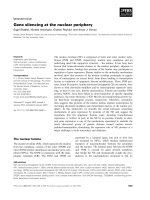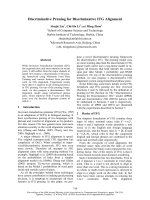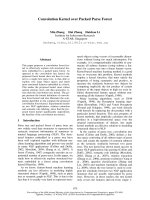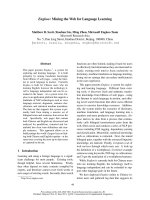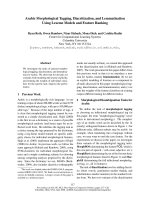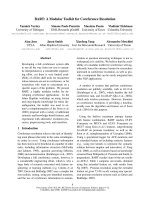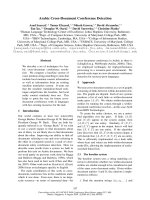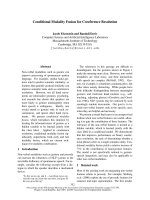Báo cáo khoa học: "Arabic Retrieval Revisited: Morphological Hole Filling" pdf
Bạn đang xem bản rút gọn của tài liệu. Xem và tải ngay bản đầy đủ của tài liệu tại đây (409.7 KB, 5 trang )
Proceedings of the 50th Annual Meeting of the Association for Computational Linguistics, pages 218–222,
Jeju, Republic of Korea, 8-14 July 2012.
c
2012 Association for Computational Linguistics
Arabic Retrieval Revisited: Morphological Hole Filling
Kareem Darwish, Ahmed M. Ali
Qatar Computing Research Institute
Qatar Foundation, Doha, Qatar
,
Abstract
Due to Arabic’s morphological complexity,
Arabic retrieval benefits greatly from
morphological analysis – particularly
stemming. However, the best known
stemming does not handle linguistic
phenomena such as broken plurals and
malformed stems. In this paper we propose
a model of character-level morphological
transformation that is trained using
Wikipedia hypertext to page title links.
The use of our model yields statistically
significant improvements in Arabic
retrieval over the use of the best statistical
stemming technique. The technique can
potentially be applied to other languages.
1. Introduction
Arabic exhibits rich morphological phenomena
that complicate retrieval. Arabic nouns and verbs
are typically derived from a set of 10,000 roots that
are cast into stems using templates that may add
infixes, double letters, or remove letters. Stems
can accept the attachment of clitics, in the form of
prefixes or suffixes, such as prepositions,
determiners, pronouns, etc. Orthographic rules can
cause the addition, deletion, or substitution of
letters during suffix and prefix attachment.
Further, stems can be inflected to obtain plural
forms via the addition of suffixes or through using
a different stem form altogether producing so-
called broken
1
(aka irregular) plurals.
For retrieval, we would ideally like to match
“related” stem forms regardless of inflected form
or attached clitic. Tolerating some form of
derivational morphology where nouns are
transformed into adjectives via the attachment of
1
“Broken” is a direct translation of the Arabic word
“takseer”, which refers to this kind of plural.
the suffix ! (y)
2
(ex. ﺮﺼﻣ (mSr) ! !ﺮﺼﻣ (mSry))
is desirable as they are semantically related.
Matching all stems that are cast from the same root
would introduce undesired ambiguity, because a
single root can produce up to 1,000 stems.
Two general approaches have been shown to
improve Arabic retrieval. The first approach
involves stemming, which removes clitics, plural
and gender markers, and suffixes such as ! (y).
Statistical stemming was reported to be the most
effective for Arabic retrieval (Darwish et al.,
2005). Though effective, stemming has the
following drawbacks:
1. Stemming does not handle infixes and hence
cannot conflate singular and broken plural word
forms. For example, the plural of the Arabic
word for book “!ﺎﺘﻛ” (ktAb) is “ﺐﺘﻛ” (ktb).
2. Stemming of some named entities, which are
important for retrieval, and their inflected forms
may produce different stems as word endings
may change with the attachment of suffixes.
Consider the Arabic words for America ﺎﻜ#ﺮ ﻣ &
(>mrykA) and American ﻲﻜ#ﺮﻣ& (>mryky), where
the final letter is transformed from “A” to “y”.
The second approach involves using character 3-
or 4-grams (as opposed to words) (Mayfield et al.,
2001; Darwish and Oard, 2002). For example, the
trigrams of “WORD” are “WOR” and “ORD”.
This approach though it has been shown to
improve retrieval effectiveness, it has the
following drawbacks:
1. It cannot handle broken plurals, though it would
handle words where stemming would produce
different stems for different inflected forms.
2. It significantly increases index sizes. For
example, using a 6 letter word would produce 4
trigram chunks, which would have 12 letters.
3. Longer words would yield more character n-
gram chunks compared to shorter ones leading to
skewed weights for query words.
2
We use Buckwalter transliteration in the paper
218
To address this problem, we propose the use of a
character level transformation model that can
generate tokens that are morphologically related to
query tokens. We train the model using
morphological related stems that are extracted
from hypertext/page title pairs from Wikipedia.
Such pairs are good for the task at hand, because
they show different ways to refer to the same
concept. We show that expanding stems in a query
with related stems using our model outperforms
the use of state-of-the-art statistical Arabic
stemming. Further, the expansion can be applied
to words directly to perform at par with statistical
stemming. Laterally, the model can help produce
spelling variants of transliterated names.
The contribution of this paper is as follows:
• We proposed an automatic method for learning
character-level morphological transformations
from Wikipedia hypertext/page title pairs.
• When applied to stems, we show that the method
overcomes some morphological problems that
are associated with stemming, statistically
significantly outperforming Arabic retrieval
using statistical stemming and character n-grams.
• When applied to words, we show that the
method yields retrieval effectiveness at par with
statistical stemming.
2. Related Work
Most studies are based on a single large collection
from the TREC-2001/2002 cross-language
retrieval track (Gey and Oard, 2001; Oard and
Gey, 2002). The studies examined indexing using
words, word clusters (Larkey et al., 2002), terms
obtained through morphological analysis (e.g.,
stems and roots (Darwish and Oard, 2002), light
stemming (Aljlayl et al., 2001; Larkey et al.,
2002), and character n-grams of various lengths
(Darwish and Oard, 2002; Mayfield et al., 2001).
The effects of normalizing alternative characters,
removal of diacritics and stop-word removal have
also been explored (Xu et al., 2001). These studies
suggest that light stemming, character n-grams,
and statistical stemming are the better index terms.
Morphological approaches assume an Arabic word
is constituted from prefixes-stem-suffixes and aim
to remove prefixes and suffixes. Since Arabic
morphology is ambiguous, statistical stemming
attempts to find the most likely segmentation of
words. The first such systems were MORPHO3
(Ahmed, 2000) and Sebawai (Darwish, 2002).
Later work by Lee et al. (2003) used a trigram
language model with a minimal set of manually
crafted rules to achieve a stemming accuracy of
97.1%. Their system was shown by Darwish et al.
(2005) to lead to statistical improvements over
using light stemming. Diab (2009) used an SVM
classifier to ascertain the optimal segmentation for
a word in context. The classifier was trained on
the Arabic Penn Treebank data. She reported a
stemming accuracy of 99.2%. Although
consistency is more important for IR applications
than linguistic correctness, perhaps improved
correctness would naturally yield great
consistency. In this paper, we used a
reimplementation of the system proposed by Diab
(2009) with the same training set as a baseline.
Concerning the automatic induction of
morphologically related word-forms,
Hammarström (2009) surveyed fairly
comprehensively many unsupervised morphology
learning approaches. Brent et al. (1995) proposed
the use of Minimum Description Length (MDL) to
automatically discover suffixes. MDL based
approach was improved by: Goldsmith (2001) who
applied the EM algorithm to improve the precision
of pairing stems prior to suffix induction; and
Schone and Jurafsky (2001) who applied latent
semantic analysis to determine if two words are
semantically related. Jacquemin (1997) used word
grams that look similar, i.e. share common stems,
to learn suffixes. Baroni (2002) extended his work
by incorporating semantic similarity features, via
mutual information, and orthographic features, via
edit distance. Chen and Gey (2002) utilized a
bilingual dictionary to find Arabic words with a
common stem that map to the same English stem.
Also in the cross-language spirit, Snyder and
Barzilay (2008) used cross-language mappings to
learn morpheme patterns and consequently
automatically segment words. They successfully
applied their method to Arabic, Hebrew, and
Aramaic. Creutz and Lagus (2007) proposed a
probabilistic model for automatic word segment
discovery. Most of these approaches can discover
suffixes and prefixes without human intervention.
However, they may not be able to handle infixation
and spelling variations. Karagol-Ayan et al. (2006)
used approximate string matching to automatically
219
map morphologically similar words in noisy
dictionary data. They used the mappings to learn
affixation, including infixiation, from noisy data.
In this paper, we propose a new technique for
finding morphologically related word-forms based
on learning character-level mappings.
Figure 1. Example hypertexts to Wikipedia titles
3. Character-Level Model
3.1 Training Data
In our experiments, we extracted Wikipedia
hypertext to page title pairs as in Figure 1. We
performed all work on an Arabic Wikipedia dump
from April 2010, which contained roughly 150,000
articles. In all, we extracted 11.47 million
hypertext-title pairs. From them, we attempted to
find word pairs that were morphologically related.
From the example in Figure 1, given the hypertext
ﺔ"ﻟﺎﻐﺗﺮﺒﻟﺎﺑ (bAlbrtgAlyp – in Portuguese) and the
page title that it points to ﺔ"ﻟﺎﻐﺗﺮﺑ ﺔﻐﻟ (lgp brtgAlyp –
Portuguese language) we needed to extract the
pairs ﺔ"ﻟﺎﻐﺗﺮﺒﻟﺎﺑ (bAlbrtgAlyp) and ﺔ"ﻟﺎﻐﺗﺮﺑ (brtgAlyp).
We assumed that a word in the hypertext and
another in Wikipedia title were morphologically
related using the following criteria:
• The words share the first 2 letters or the last 2
letters. This was intended to increase precision.
• The edit distance between the two words must be
<= 3. The choice of 3 was motivated by the fact
that Arabic prefixes and suffixes are typically 1,
2, or 3 letters long.
• The edit distance was less than 50% of the length
of the shorter of the two words. This was
important to insure that short words that share
common letters but are in fact different are
filtered out.
The word pairs that matched these criteria were
roughly 13 million word pairs
3
. All words in the
word pairs were stemmed using a
reimplementation of the stemmer of Diab (2009).
3.2 Alignment and Generation
Alignment: We performed two alignments. In the
first, we aligned the stems of the word pairs at
character level. In the second, we aligned the
words of the word pairs at character level without
stemming. The pairs were aligned using Giza++
and the phrase extractor and scorer from the Moses
ma-chine translation package (Koehn et al., 2007).
To apply a machine translation analogy, we treated
words as sentences and the letters from which were
constructed as tokens. The alignment produced
letter sequence mappings. Source character
sequence lengths were restricted to 3 letters.
Generating related stems/words: We treated the
problem of generating morphologically related
stems (or words) like a transliteration mining
problem akin to that in Udupa et al. (2009).
Briefly, the miner used character segment
mappings to generate all possible transformations
while constraining generation to the existing
tokens (either stems or words) in a list of unique
tokens in the retrieval test collection.
Basically, given a query token, all possible
segmentations, where each segment has a
maximum length of 3 characters, were produced
along with their associated mappings. Given all
mapping combinations, combinations producing
valid target tokens were retained and sorted
according to the product of their mapping
probabilities. To illustrate how this works, consider
the following example: Given a query word “min”,
target words in the word list {moon, men, man,
min}, and the possible mappings for the segments
and their probabilities:
m = {(m, 0.7), (me, 0.25), (ma, 0.05)}
mi = {(mi, 0.5), (me, 0.3), (m, 0.15), (ma, 0.05)}
n = {n, 0.7), (nu, 0.2), (an, 0.1)}
in = {(in, 0.8), (en, 0.2)}
The algorithm would produce the following
candidates with the corresponding channel
probabilities:
(min!min:0.56): (m! m: 0.7); (in!in: 0.8)
(min!men:0.18): (m!m: 0.7); (in!en: 0.2)
3
The training data can be obtained from:
Title:
ﺔ"ﻟﺎﻐﺗ'ﺑ ﺔﻐﻟ
Title:
)ﺎﻐﺗ'ﺑﻟ*
220
(min!man:0.035): (mi!ma: 0.05); (n!n: 0.7)
The implementation details of the decoder are
described in (El-Kahki et al., 2012).
4. Testing Arabic Retrieval Effectiveness
4.1 Experimental Setup
We used extrinsic IR evaluation to determine the
quality of the related stems that were generated.
We performed experiments on the TREC
2001/2002 cross language track collection, which
contains 383,872 Arabic newswire articles and 75
topics with their relevance judgments (Oard and
Gey, 2002). This is presently the best available
large Arabic information retrieval test collection.
We used Mean Average Precision (MAP) as the
measure of goodness for this retrieval task. Going
down from the top a retrieved ranked list, Average
Precision (AP) is the average of precision values
computed at every relevant document found. MAP
is just the mean of the AP’s for all queries.
All experiments were performed using the Indri
retrieval toolkit, which uses a retrieval model that
combines inference networks and language
modeling and implements advanced query
operators (Metzler and Croft, 2004). We used a
paired 2-tailed t-test with p-value less than 0.05 to
determine if a set of retrieval results was better
than another.
We replaced each query tokens with all the
related stems that were generated using a weighted
synonym operator (Wang and Oard, 2006), where
the weights correspond to the product of the
mapping probabilities for each related word. With
the weighted synonym operator, we did not need to
threshold the generated related stems as ones with
low probabilities were demoted. Probabilities were
normalized by the score of the original query word.
For example, given the stem !ﺎﻨﺻ (SnAE) it was
replaced with: #wsyn(1.000 SnAE 0.029 SnAEy
0.013 SnE 0.006 SnAEA 0.003 mSnwE).
We used three baselines to compare against,
namely: using raw words, using statistical
stemming (Diab, 2009), and character 4-grams. For
all runs, we performed letter normalization, where
we conflated: variants of “alef”, “ta marbouta” and
“ha”, “alef maqsoura” and “ya”, and the different
forms of “hamza”.
4.2 Experimental Results
Table 1 reports retrieval results. Expanding stems
using morphologically related stems yielded
statistically significant improvements over using
words, stems, and character 4-grams. Expanding
words yielded results that were statistically
significantly better than using words, and
statistically indistinguishable from using 4-grams
and stems. As the results show, the proposed
technique improves upon statistical stemming by
overcoming the shortfalls of stemming. Another
phenomenon that was addressed implicitly by the
proposed technique had to do with detecting
variant spellings of transliterated names. This
draws from the fact that differences in spelling
variations and the construction of broken plurals
are typically due to the insertion or deletion of long
vowels. For example, given the name “ﻮ"ﺎ$ﻨﺘﻧ”
(ntnyAhw– Netanyahu), the model proposed:
ntynyAhw, ntAnyAhw, and ntAnyhw.
5. Conclusion
In this paper, we presented a method for generating
morphologically related tokens from Wikipedia
hypertext to page title pairs. We showed that the
method overcomes some of the problems of
statistical stemming to yield statistically significant
improvements in Arabic retrieval over using
statistical stemming. The technique can also be
applied on words to yield results that statistically
indistinguishable from statistical stemming. The
technique had the added advantage of detecting
variable spellings of transliterated named entities.
For future work, we would like to try the
proposed technique on other languages, because it
would likely be effective in automatically learning
character-level morphological transformations as
well as overcoming some of the problems
associated with stemming. It is worthwhile to
devise models that concurrently generate
morphological and phonologically related tokens.
Table 1. Retrieval Results
Run
MAP
Statistically better than
Words
0.225
Stems
0.276
words
Char 4-grams
0.244
Expanded Words
0.264
words
Expanded Stems
0.296
words/stems/char 4-grams
221
References
M. A. Ahmed. (2000). A Large-Scale Computational
Processor of the Arabic Morphology, and
Applications. A Master’s Thesis, Faculty of
Engineering, Cairo University, Cairo, Egypt.
M. Aljlayl, S. Beitzel, E. Jensen, A. Chowdhury, D.
Holmes, M. Lee, D. Grossman, O. Frieder. IIT at
TREC-10. In TREC. 2001. Gaithersburg, MD.
M. Baroni, J. Matiasek, H. Trost (2002). Unsupervised
discovery of morphologically related words based on
orthographic and semantic similarity. ACL-2002
Workshop on Morphological & Phonological Learn-
ing, pp. 48-57.
M. Brent, S. Murthy, A. Lundberg (1995). Discovering
Morphemic Suffixes: A Case Study in Minimum
Description Length Induction. 15th Annual
Conference on the Cognitive Science Society, pp. 28-
36.
A. Chen, F. Gey (2002). Building an Arabic Stemmer
for Information Retrieval. TREC-2002.
M. Creutz, K. Lagus (2007). Unsupervised models for
morpheme segmentation and morphology learning.
Speech and Language Processing, Vol. 4, No 1:3,
2007.
K. Darwish. (2002). Building a Shallow Morphological
Analyzer in One Day. ACL Workshop on
Computational Approaches to Semitic Languages.
2002.
K. Darwish, H. Hassan, O. Emam (2005). Examining
the Effect of Improved Context Sensitive Morpholo-
gy on Arabic Information Retrieval. ACL Workshop
on Computational Approaches to Semitic Languages,
pp. 25–30, 2005.
K. Darwish, D. Oard. (2002). Term Selection for
Searching Printed Arabic. SIGIR, 2002, p. 261 - 268.
M. Diab (2009). Second Generation Tools (AMIRA
2.0): Fast and Robust Tokenization, POS tagging,
and Base Phrase Chunking. 2nd Int. Conf. on Arabic
Language Resources and Tools, 2009.
A. El-Kahki, K. Darwish, M. Abdul-Wahab, A. Taei
(2012). Transliteration Mining Using Large Training
and Test Sets. NAACL-2012.
F. Gey, D. Oard (2001). The TREC-2001 Cross-
Language Information Retrieval Track: Searching
Arabic Using English, French or Arabic Queries.
TREC, 2001. Gaithersburg, MD. p. 16-23.
J. Goldsmith (2001). Unsupervised Learning of the
Morphology of a Natural Language. Journal of
Computational Linguistics, Vol. 27:153-198, 2001.
H. Hammarström (2009). Unsupervised Learning of
Morphology and the Languages of the World. Ph.D.
Thesis, Dept. of CSE, Chalmers Univ. of Tech. and
Univ. of Gothenburg.
C. Jacquemin (1997). Guessing morphology from terms
and corpora. ACM SIGIR-1997, p.156-165.
B. Karagol-Ayan, D. Doermann, A. Weinberg (2006).
Morphology Induction from Limited Noisy Data Us-
ing Approximate String Matching. 8th ACL SIG on
Comp. Phonology at HLT-NAACL 2006, pp. 60–68.
P. Koehn, H. Hoang, A. Birch, C. Callison-Burch, M.
Federico, N. Bertoldi, B. Cowan, W. Shen, C. Moran,
R. Zens, C. Dyer, O. Bojar, A. Constantin, E. Herbst
(2007). Moses: Open Source Toolkit for Statistical
Machine Translation, ACL-2007, demonstration
session, Prague, Czech Republic, June 2007.
L. Larkey, L. Ballesteros, and M. Connell (2002). Im-
proving Stemming for Arabic Information Retrieval:
Light Stemming and Co-occurrence Analysis. SIGIR
2002. pp. 275-282.
Y. Lee, K. Papineni, S. Roukos, O. Emam, H. Has-san
(2003). Language Model Based Arabic Word
Segmentation. ACL-2003, p. 399 - 406.
J. Mayfield, P. McNamee, C. Costello, C. Piatko, A.
Banerjee. JHU/APL at TREC 2001: Experiments in
Filtering and in Arabic, Video, and Web Retrieval. In
TREC 2001. Gaithersburg, MD. p. 322-329.
D. Metzler, W. B. Croft (2004). Combining the Lan-
guage Model and Inference Network Approaches to
Retrieval. Information Processing and Management
Special Issue on Bayesian Networks and Information
Retrieval, 40(5), 735-750, 2004.
D. Oard, F. Gey (2002). The TREC 2002
Arabic/English CLIR Track. TREC-2002.
P. Schone, D. Jurafsky (2001). Knowledge-free induc-
tion of inflectional morphologies. ACL 2001.
B. Snyder, R. Barzilay (2008). Unsupervised Multilin-
gual Learning for Morphological Segmentation.
ACL-08: HLT, pp. 737–745, 2008.
R. Udupa, K. Saravanan, A. Bakalov, A. Bhole. 2009.
"They Are Out There, If You Know Where to Look":
Mining Transliterations of OOV Query Terms for
Cross-Language Information Retrieval. ECIR-2009,
Toulouse, France, 2009.
J. Wang, D. Oard (2006). Combining Bidirectional
Translation and Synonymy for Cross-language In-
formation Retrieval. SIGIR-2006, pp. 202-209.
J. Xu, A. Fraser, and R. Weischedel (2001). 2001 Cross-
Lingual Retrieval at BBN. TREC 2001, pp. 68 - 75.
222
